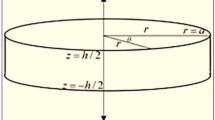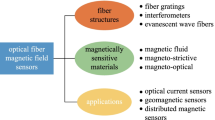Abstract
We have developed a dc-SQUID amplifier with intra-coil resistors based on second-order parallel gradiometers. The measured results show that intra-coil resistors can significantly increase the flux–voltage transfer coefficient VΦ as well as smooth out resonances and produce a smooth flux–voltage (V–Φ) characteristic curve. It has been observed through a comparison of various intra-coil damping resistors that the flux–voltage transfer coefficient VΦ as a function of the resistance of the intra-coil resistors rises as the corresponding electrical conductance increases. The measured results of the flux noise at 4.2 K demonstrate explicitly that the flux–voltage transfer coefficient can greatly increase detection sensitivity and successfully reduce the noise contribution from the electronics operating at room temperature.





Similar content being viewed by others
References
J. Clarke, A.I. Braginski, The SQUID Handbook (Wiley, New York, USA, 2004)
R.L. Fagaly, Rev. Sci. Instrum. 77, 101101 (2006). https://doi.org/10.1063/1.2354545
M.E. Huber, A.H. Steinbach, R.H. Ono, Physica C 351, 85 (2001). https://doi.org/10.1016/S0921-4534(00)01627-0
Dietmar Drung, IEEE/CSC & ESAS Superconductivity News Forum (global edition), April 2016
C.D. Tesche, J. Clarke, J. Low Temp. Phys. 29, 301–331 (1977). https://doi.org/10.1007/BF00655097
K. Enpuku, T. Muta, K. Yoshida, F. Irie, J. Appl. Phys. 58(5), 1 (1985). https://doi.org/10.1063/1.335998
D. Drung, Supercond. Sci. Technol. 16(12), 1320–1336 (2003). https://doi.org/10.1088/0953-2048/16/12/002
F.C. Wellstood, C. Urbina, J. Clarke, Appl. Phys. Lett. 50, 772–774 (1987). https://doi.org/10.1063/1.98041
R.P. Welty, J.M. Martinis, IEEE Trans. Magn. 27, 2924–2926 (1991). https://doi.org/10.1109/20.133821
X. Xie, Y. Zhang, H.W. Wang et al., Supercond. Sci. Technol. 23(6), 065016 (2010). https://doi.org/10.1088/0953-2048/23/6/065016
S. Kempf, M. Wegner, L. Gastaldo, A. Fleischmann, C. Enss, J. Low Temp. Phys. 176, 426–432 (2014). https://doi.org/10.1007/s10909-013-1041-0
Wu. Wentao, T. Liang, Z. Lin et al., Physica C 591, 1353976 (2021). https://doi.org/10.1016/j.physc.2021.1353976
L. Ying, X. Zhang, M. Niu, J. Ren, W. Peng, M. Meazawa, Z. Wang, IEEE Trans. Appl. Supercond. 31, 5 (2021). https://doi.org/10.1109/TASC.2021.3065277
D. Drung, C. Hinnrichs, H. Barthelmess, Supercond. Sci. Technol. 19, S235–S241 (2006). https://doi.org/10.1088/0953-2048/19/5/S15
Y. Wang, G. Zhang, S. Zhang, X. Xie, IEEE Trans. Appl. Supercond. 30, 1601307 (2020). https://doi.org/10.1109/TASC.2020.3024229
S.I. Davis, J.R. Kirtley, K.A. Moler, Sensors 20, 204 (2020). https://doi.org/10.3390/s20010204
Acknowledgements
We thank all the engineers working at the Superconducting ELectronics Facility (SELF), of the Shanghai Institute of Microsystem and Information Technology, for their technical support. This work was supported by National Natural Science Foundation of China [Grant Number 12273099].
Author information
Authors and Affiliations
Contributions
WW contributed to conceptualization, methodology, writing—original draft, data curation, and formal analysis; ZL made a supervision for this work; ZN performed the fabrication of this work; SZ performed the measurement at a temperature of 4.2 K; GZ contributed to the measurement system; YW contributed to discussion and analysis of the data; LY contributed to the development of fabrication process; WP performed operation and maintenance of fabrication platform; LY revised the manuscript; ZW provided the funding support. All persons mentioned above made substantial contributions to the work reported in the manuscript. In addition, the engineers working at the Superconducting ELectronics Facility (SELF), of the Shanghai Institute of Microsystem and Information Technology provide their technical support for fabrication process, but who are not co-author and are named in the acknowledge section of the manuscript and have given their written permission to be named. I agree to be accountable for all aspects of the work in ensuring that questions related to the accuracy or integrity of any part of the work are appropriately investigated and resolved.
Corresponding author
Ethics declarations
Conflict of interest
The authors declare no competing interests.
Additional information
Publisher's Note
Springer Nature remains neutral with regard to jurisdictional claims in published maps and institutional affiliations.
Rights and permissions
Springer Nature or its licensor (e.g. a society or other partner) holds exclusive rights to this article under a publishing agreement with the author(s) or other rightsholder(s); author self-archiving of the accepted manuscript version of this article is solely governed by the terms of such publishing agreement and applicable law.
About this article
Cite this article
Wu, W., Lin, Z., Ni, Z. et al. Development of a dc-SQUID Amplifier with Intra-Coil Resistors. J Low Temp Phys 214, 143–151 (2024). https://doi.org/10.1007/s10909-023-03029-2
Received:
Accepted:
Published:
Issue Date:
DOI: https://doi.org/10.1007/s10909-023-03029-2




